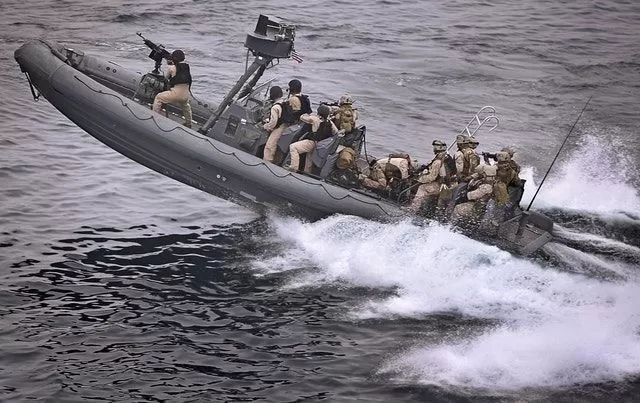
The United States Navy Seal program develops warriors on the battlefield par excellence. These are men who are the very best at dealing with crisis management situations that most of us can’t begin to contemplate and handling them with crack efficiency. Unfortunately many of us reading this, myself included, never realize that game excellence until one or more of them make headlines by making the ultimate sacrifice for their cause, their unit, and their country.
But what exactly makes these guys so exceptional at what they do, and can those skills, or variations of them, be developed in people like you and I and used in our daily routines to make us the best in our own respective career universes?
The answer is yes, but it isn’t for the faint of heart and it won’t be easy.
I’m going to focus on the practice of technology Sales here (in my case to the Federal Government), but the crisis management process you’ll read about isn’t limited to any one discipline. It can apply to any walk of life. This topic is pretty expansive and can be covered in a book that I’m not qualified to write, to be sure, so I’m going to focus on just one aspect of Navy Seal behavior—crisis response.
Uncommon Crisis Response
I sat frozen in my theater seat watching, mouth agape, at the incredible situations encountered by Marcus Luttrell, Michael Murphy and the other heroes chronicled in the film, Lone Survivor. The thing that struck me the most besides the obvious courage was how these men responded in a situation gone horribly wrong, facing a crisis that wasn’t planned for, and how they kept forging ahead after being physically beaten down and against impossible odds.
Another film, Act of Valor, showed the same characteristic of bravery from the Seals, and also the rapid decision-making and crisis management that gave rise to new missions as a result of new data, with a remarkably short time from the receipt of changing information about the threat to the continental US to the deployment of warriors into tactical positions to neutralize it. Similar on-the-fly adjustments were made by SpecOps group Seal Team 6 during the 2011 capture and kill of Osama Bin Laden.
Worse Case Sales Crises
In your world of business, what kind of crises can occur that require this type of response, and what kind of crisis management skills would you need to develop to deal with them? It goes without saying that for most of us, the situations that military heroes like the Navy Seals face go far beyond anything we’ll see in the business world, where the specter of death is usually not a possible outcome. Having said that, what might some of the Sales crises be that you just may face? Here are just a few:
- Major Product Failure – Something has failed in the field that not only has had major consequences for existing customers, it has become public industry knowledge and the company reputation is on the ropes.
- Loss of a Major Customer – Depending upon how many baskets hold the company sales eggs, the loss of a major customer can be devastating financially.
- Game-changing Competitor – Sometimes a new competitor not only shows up to butt heads with your firm, but it introduces a radical technology or process that may change your industry or how customers buy.
- Unforeseen Market Forces – When markets crash or global economic crises occur (see 2008), customers put moratoriums on purchasing and scale back in full survival mode, regardless of your products or sales ability.
There are many more to be sure, but these can get your mind around things that might cause major disruption to your company’s plans and business continuity.
Developing Seal Crisis Management
I recently finished a book by former US Navy Seal Mark Divine called The Way of the Seal, where the author gets into details on the things that the seals did physically, mentally and spiritually to develop warriors, and how regular Joes like you and I can use comparable regimens to achieve excellence in business. Mark even runs Sealfit Academies where people pay good money to put themselves through unbelievable physical and mental tasks, often training for months or years to just attend, so they can attain that personal reference point for their lives. They know the value of not only learning new ways to think, visualize and train, but also the value of perspective. Compared to the camp experience, the risks and decisions that they face in their business lives are a big step down on the crisis management scale, and in the future can be handled with calm efficiency.
I won’t regurgitate Mark’s book here. It’s a good read and I recommend you get it. The principal thrust that I got out of it wasn’t tactical, but ways of making better, more focused, courageous and resilient individuals. This is my take on Navy Seal skills and how to apply them in business; particularly, Sales.
Mental Training
The Seals have a heavy dose of mental training that candidates go through in Seal school. By this I mean visualization skills, seeing things in your mind’s eye before they happen. Positive affirmations supporting goals and objectives and, more importantly, who you want to become, are part of the program. Two things surprised me about this: first, that tough guys like the Seals find this so important as to spend a lot of time on it, and second, how hard these exercises really are. The reason that the WOS (Way of the Seal) mental training is so tough is that they require you to stop, slow down, and find an undisturbed and totally silent place to act them out. In a society that stresses nearly constant action and motion as part of business success, I found it difficult to actually do this, but rewarding once I pushed through and did it. Silence is a little uncomfortable, and clearing your mind in order to do things like visualize solutions to problems is incredibly challenging. Lots of little distracting thoughts try to get in your wa
So for the Sales crises we talked about, calmly visualizing and brainstorming solutions, with more emphasis on the successful results than on the how, leads to ideas on responses that may work. Then write down those concepts and all potential tactics that will lead to the how-to part. You’re developing a cache of solutions to draw upon in the event the real crisis comes about. The most important part of this whole technique is to arrive at these solutions in advance, devoid of emotion or panic, for absolute clarity and the best possible outcomes.
This sounds hokey and is something you’ve heard before, but the mental training and visualization of the Navy Seals is exactly the same process that world class athletes use for top performance in sport. You may feel silly going through the exercise until you do it enough times that you start to believe it and it doesn’t feel silly any longer. That’s when the change starts to happen.
Conditioning
The conditioning that the Seals go through is physical. You can see it in the opening frames of Lone Survivor and Mark Divine talks about these grueling physical tasks in his book. These physical challenges that candidates have to overcome can, to a degree, get a person physically fit, but the resultant of the activities is subconscious, spiritual and builds mental toughness. For battle situations, it builds the ability to marginalize pain associated with extreme temperatures, physical exhaustion, and combat wounds. In our world of business and Sales, it is the perspective that nothing you will face is as hard as what you’ve voluntarily put yourself through. That builds incredible confidence to take calculated risks without being paralyzed by fear, fear that often leads to inaction with worse results than driving forward and doing something
Does this mean you have to go to a camp and act like a Navy Seal to condition yourself and strengthen your crisis management muscles? No, but I told you it wasn’t easy. It does mean you need to take some action that pushes you beyond where you think you can go physically. That might mean committing to 5 days a week at the gym for couch potatoes, or going through Cross-Fit training for 6 months until you lose 50 pounds. For me it meant running my first two marathons at age 48, something a year ago I never thought I could or even would want to do. Now things like half-marathons seem easy by comparison, and I transition that thinking to the arduous process of sales, often working long hours and performing hundreds of activities before the finish line is seen.
What you chose to do is up to you, but understand that the axiom of “no pain, no gain” is in full effect. You may start with 10 minutes on the treadmill walking, but you need to end up someplace that you didn’t think you could get and cannot perform easily, else you’re not stretching enough and results will be limited.
Contingency Planning
Navy Seals react so well to adverse situations because in many cases, they have thought through the scenarios and developed plans to deal with them. They do this so much with the skills of visualization and the confidence born of conditioning that full contingency plans can be developed to a high degree of detail in amazingly short order, as in the Act of Valorexample.
I can write a book on how to develop a plan, and many authors already have. The important thing is to use the responses gleened from mental training and actually develop one, or two or as many as you need to have a known process for when crisis happens.
I’m sure you have heard and maybe experienced organization-wide business continuity plans for things like natural disasters or terrorist attacks. How are human and physical assets secured? What about data backups? The same type of crisis management plans should be on the drawing board for Sales crises like the loss of a major customer or a game-changing event in your industry. Once you foresee these possibilities and develop response strategies, you may find out that it makes good business sense to proactively put the plans into effect before crisis occurs. Why wait until the one customer that makes up 50% of your company sales is gone before you move on new business development activities to avoid that exposure in the first place?
New Data, New Decisions
So there really is no mystery as to how to apply Navy Seal techniques to your business to deal with crisis management situations. The entire regimen of mental training, conditioning, and contingency planning is designed to enable rapid and effective decisions, to put the decision to action process on steroids. Even when situations occur out of left field that are completely unanticipated, they will either be close enough to a situation you have planned for to leverage ideas and practices, or at least you’ll have the mental toughness and confidence to respond with calm assurance and take the best route to success. You may not be a Navy Seal, but by developing your own Seal crisis response process, you’ll be acting like one for your business.
